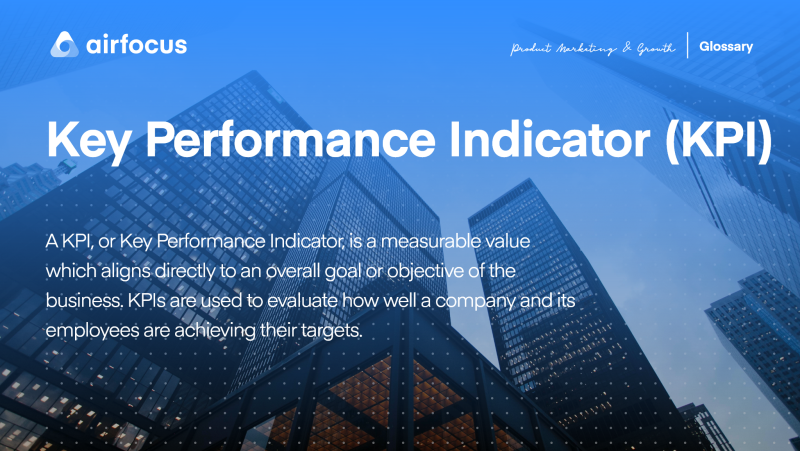Key Performance Indicator (KPI)
What is a Key Performance Indicator (KPI)
Definition of a Key Performance Indicator (KPI)
A KPI, or Key Performance Indicator, is a measurable value that aligns directly to an overall goal or objective of the business. KPIs are used to evaluate how well a company and its employees are achieving their targets.
If you’ve ever run or managed any part of a business, you’ll know just how important it is to stick to an overall strategy or roadmap. All it takes is a few uncommunicated course adjustments from different teams to send a startup off course.
Luckily, there’s a solution: defining realistic and achievable KPIs, or Key Performance Indicators, for all teams.
By setting KPIs throughout the business, you can ensure that everyone is pulling in the same direction — and you can actually measure their progress, too.
Examples of KPIs
Because Key Performance Indicators can vary from business to business — and, indeed the departments within them — a good way to better understand how they work is with a few examples.
With that in mind, let’s look at a few different KPIs across different industries and internal teams.
For a SaaS company, a core KPI could be to achieve a certain number of monthly active users.
For a revenue-focused business, you may choose to hit a certain average order value per customer.
Service-based B2B companies may want to focus their KPIs on CLV, or Customer Lifetime Value.
For almost any business in the world, the most basic of KPIs may be to increase revenue by 20% year-on-year.
As you can see, there really is no one-size-fits-all template when it comes to Key Performance Indicators.
While all businesses will have some crossover in their long-term goals from a business plan — especially financially — they can be worlds apart in other areas. When defining your KPIs, it’s important to understand what makes your business unique and what your long-term goal really is.
How to define KPIs for your business
Now that you’re familiar with what Key Performance Indicators are, and what they may look like, let’s consider how to define them. Again, it’s important to stress that this process will be radically different for every business depending on industry, vertical, corporate structure, and so on.
That said, there are certain common factors which make up the essence of a good quality KPI. Before even thinking about the specifics of your KPIs, you should first ensure you’re familiar with the format.
So, here we go. Properly defined Key Performance Indicators should be:
Quantifiable by real-world metrics. For example, a certain percentage increase compared to last quarter.
Clearly linked to an overall goal of the business itself.
Able to be understood by anyone (even those outside of the business).
By keeping these elements in mind, you’ll be able to define KPIs which are both realistic and achievable. (Because if they’re not, you’ll soon find out).
Okay, so that’s the theory of a Key performance indicator — but how do you define them in practice?
Because, as we’ve discussed, all businesses are unique, there is no set-in-stone process for this. Although there are some questions you can ask of your business to help you set quality KPI targets:
What is the outcome you want to see from this KPI? In other words, you need to define exactly what benefits this particular goal will bring and how it will align with the larger goals of the company.
Which team or individual is responsible for this outcome? Every KPI needs someone to achieve it, and it’ll be up to you to assign it to the best person (or people) for the job.
By which metric will the outcome be measured? This could be a percentage increase or decrease, a specific financial goal being reached, a specific number of users, and so on. The most important thing here is that the outcome can be stated in objective terms.
How will progress towards the goal be tracked? This is really a tactical question, but it’s nonetheless an important one. Put simply, you need to be able to give your employees the ability to track their progress towards a goal. This will also act as a motivator to keep them working towards success.
The pros and cons of using KPIs
It may seem like Key Performance Indicators are the answer to all of your company’s problems.
After all, they ensure teams are accountable and all working towards a common goal: what’s not to love? Well, like all things in life, KPIs have their good side and their bad.
So let’s lay out both sides of the KPI coin...
The pros
The progress your business is making towards its goals is genuinely measurable.
You can ensure that all departments are aligned with the overall goal of the business.
It becomes far easier to manage promotions and salary negotiations because employees can be judged objectively using KPIs.
The cons
Because KPIs are short-term goals, often covering single months or quarters, teams can become overly focused on the short-term view and the longer-term vision can suffer.
KPIs are structured so specifically that employees can become stifled creatively, leading to a slump in innovation and/or new ideas.
Whether or not you choose to define KPIs in your small business or startup is very much up to you. If you’re still not certain about whether they’d help, why not run the idea by your internal teams and come to a group decision?
After all, if Key performance indicators have taught us anything, it’s that working together is the very best way to succeed.

General FAQ

Glossary categories
Experience the new way of doing product management

Experience the new way of doing product management








